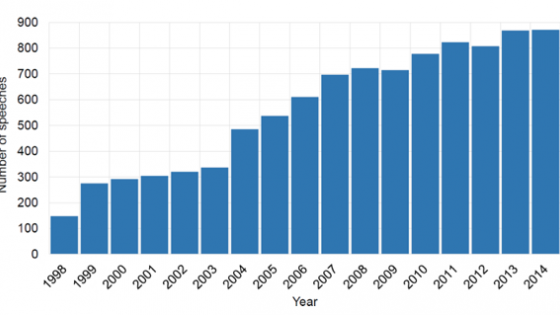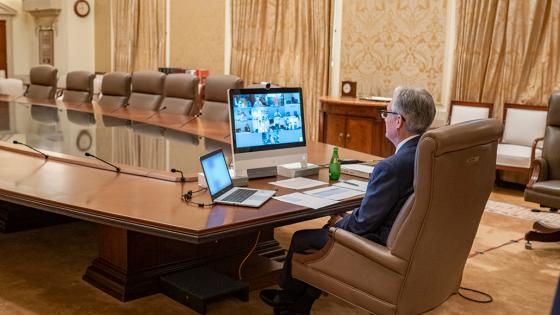“The future is not ours to see” as the song has it; and even if the point forecast, for growth, inflation, interest rates, etc., one or two years hence should be the best possible, the probability of it being exactly right is minimal. Not only are unforeseen, and unforeseeable, events bound to impinge, but also the models used will inevitably be a limited, and often flawed, representation of our complex economic reality.
Bank of England Governor Mervyn King tried to get observers to understand the reality of future uncertainty by focusing more on the shape, and skewness, of the fan chart, rather than on the single modal point forecast. This laudable effort can only be described as a gallant failure. The initial attempts to predict either the likely volatility of outcomes, i.e. the width of the fan chart or its skewness, were not particularly successful (see Section 5 of Goodhart and Pradhan 2023). His successor, Governor Mark Carney, effectively abandoned this approach by holding the width of the fan constant, with zero skew, during most of his time in office. Although the current Chief Economist, Huw Pill, and Governor Andrew Bailey have partially resurrected King’s approach, by applying a large upside skew (risk) to a fan of much increased width, most commentators have shown little or no interest in that, concentrating their attention solely on the modal point forecasts for inflation, growth, and interest rates.
Such single point (modal) forecasts are easy to comprehend and to check subsequently against outcomes. They are what, otherwise busy, politicians want to get. But it is, at least, arguable that they are not what central banks should provide. There are several reasons why the focus purely on a single point forecast is not in the best interests of a central bank.
The first reason is that the present approach inevitably focuses on the deviations of outcomes from the point target, not giving enough appreciation that there is nothing sacred about that point and being in the same region may be good enough, or in some cases even better. For example, and in particular, the years from about 2011 to 2018 were characterised by very strong and beneficial supply shocks, reducing inflation, but in a good way. If there had been much less concern about hitting the 2% target exactly, there would have been less pressure on central banks to introduce exaggerated, almost certainly unnecessary, and – with the benefit of hindsight – undesirable extreme expansionary measures, such as quantitative easing (when there was no liquidity crisis), negative interest rates, and a commitment not only to ‘lower for longer’ but even to try to get some future averaging of inflation.
Second, the world that we live in is not one where the probabilities of outcomes are known, but where there is radical uncertainty about future developments in geopolitics, climate, technology, and so on. Under these circumstances the potential range of outcomes is always quite large. What is needed, instead of single point targets, is scenarios. What needs to be improved is the speed of adjustment to the arrival of new events and conditions. While this is now described as ‘data dependence’, such data are inevitably backward looking, and we need to adjust our forecasts for the future to our changing views about how the world is working.
So, the argument here is that there is a better way forward, rather than the reliance on single point forecasts combined with a largely ignored fan chart. This is that each central bank should present scenarios of what might happen (‘what if’) if conditions turn out to be better or worse, with some kind of prediction both for interest rates and inflation in each case. One essential would be that the scenarios must be presented as an even number (2, 4, etc.). There has been a tendency for the staff of central banks to provide three scenarios. This is usually calibrated by the staff so that the middle scenario is the obvious choice, and the two outer (extreme) scenarios are actually only there for show and are widely ignored. As a result, everyone focuses on the point forecast related to the middle scenario, and we are exactly back in the old system.
Another useful requirement of such a scenario approach would be that the central bank should not try to give an exact quantification of the probability of either scenario occurring. Such a quantification in any case would be inaccurate and misleading. If there was to be such a quantification, observers would simply apply the presumed probability for interest, inflation, etc., and get back to a single point forecast. Instead, the central bank could say that they thought that one of their two (or four) scenarios was more likely, or somewhat more likely, or use other such qualitative language.
To conclude, the provision of point forecasts, to commentators seeking simplicity and certainty where none can in reality be found, is undesirable; a scenario approach would be better. Nevertheless, the present is not a good time for making such a major change to central bank communications. With inflation remaining rather persistently above target, and credibility faltering, commentators would be almost bound to regard this change as a smokescreen for a continued failure to hit the single point target. The time to make the change is when the target has been regained on average for a year, or two.
Doing forecasts for two scenarios, rather than the most single likely outcome, would perhaps cause more work and effort from the staff, but should be worthwhile. The scenarios could be chosen by the Monetary Policy Committee (MPC), sufficiently far in advance to give the staff time to do both exercises. The choice of scenarios in itself might be a useful means of making MPC members thoughtful about possible future ways in which problems of monetary management might occur.
Author’s note: I thank Professor R. Lastra for helpful comments, but all erroneous ideas remain my own responsibility.
References
Goodhart, C and M Pradhan (2023), “A Snapshot of Central Bank (Two Year) Forecasting: A Mixed Picture”, CEPR Discussion Paper 18043.



